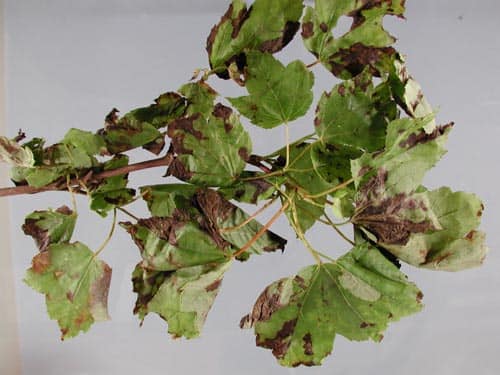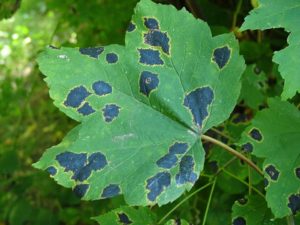Anthracnose & Tar Spots are two common fungal diseases that many towns see in their trees. You may see these in trees around the City of Blue Island, especially after cool, wet Spring seasons, but not to worry: both of these fungal diseases are mostly an aesthetic issue and rarely fatal for trees.

ANTHRACNOSE OF SHADE TREES
One of the most common and unsightly diseases of shade trees is anthracnose. Anthracnose is a foliar disease caused by several species of fungi whose spores, when released, infect newly emerging leaves. The disease, which becomes active in spring, can become severe when cool, wet spring weather persists. Unfortunately, trees most likely to be affected are quite common, such as ash, dogwood, elm, hickory, maple, oak, sycamore, and walnut.
SYMPTOMS
Tan to brown or black blotched areas on leaves developing along the leaf veins. The most common symptoms of anthracnose are tan to brown or black blotched areas on leaves which develop along the leaf veins. Frequently, the infected area will expand outward to the leaf margin causing irregular, brown patches and distortion of the leaf.
Young leaves may die and fall off soon after infection, but most trees re-leaf by mid-summer. Tiny fungal masses can be seen through a magnifying lens on the underside of the leaf. Leaf injury is most noticeable on the lower branches. Numerous cankers (localized, injured areas) may occur on stems and branches.
Anthracnose is a more serious infection on plants whose twigs and buds are susceptible, such as sycamore and flowering dogwood. In the spring, spores are dispersed to new shoots and buds, often killing buds before new leaves emerge. Sycamores appear more dead than alive in early spring because of the severe attack from anthracnose. However, they will re-leaf by summer.
CAUSE
Anthracnose is a generic name for a disease caused by several species of fungi in genera including Discula, Apignomonia, and Colletotrichum. During winter, these fungi reside in diseased leaf and stem tissue, and on the ground in fallen leaves. In early spring, infectious spores are produced which are carried by rain and wind to newly emerging leaves. Additional spores are produced from recently infected leaf tissue, causing further spread of the disease during the growing season.
Temperature and rainfall are the two key factors determining the severity of anthracnose. Mean daily temperatures (the average of the maximum and minimum temperatures) between 50-57 degrees Fahrenheit during bud break and early leaf development are crucial for spore production and infection to occur. Higher or lower average temperatures during this period will reduce disease severity. Frequent rain aids the dispersal of spores and also allows for a greater number of infections.
MANAGEMENT
The severity of anthracnose varies each year with weather; however, even in those years when the disease is severe, anthracnose will not result in tree death. Most trees are able to withstand infection and push out a new crop of leaves by mid-June. Therefore, the most practical control is good sanitation practices to keep trees healthy. Discard fallen leaves to reduce the potential for reinfection, prune infected twigs and branches (with cankers) back to healthy wood, fertilize lightly, and water stricken trees to help them recover from severe defoliation.

TAR SPOT
Tar spot is a fungal disease that causes a great deal of concern for home gardeners due to its appearance. Luckily, this disease is generally a cosmetic problem, rather than a real health issue for trees. The tar spot seen on maples is caused by three related fungi, Rhytisma acerinum, R. americanum and R. punctatum. Symptoms vary slightly from pathogen to pathogen, but all three organisms produce fungal spots that do look like spots of tar. While tar spot can affect many species of maple, it is commonly reported on Norway, silver and red maples.
SYMPTOMS
Early symptoms of tar spot start to develop on leaves in early summer, but often go unnoticed as they are fairly inconspicuous. At this stage, the leaf spots are light green to yellow green. It is not until mid to late summer that the darker coloration of the spots shows up. Development of the tar spot varies by the species of pathogen. One species produces tiny black spots that later coalesce into larger black spots that may be 1/3 to 1/2 inch in diameter. These spots will eventually be slightly raised. Another species of the pathogen causes dark spots that may be an inch or more in diameter. These spots are usually more prominently raised and have a textured surface. The third tar spot pathogen causes smaller spots, and this form of tar spot has been referred to as speckled tar spot.
Late in the season, tar spot may cause some leaves to drop early. The number is generally not significant and so, little to no harm is done to the host tree. Tar spot often goes unnoticed on the host tree until some of the leaves begin to fall.
MANAGEMENT
The black spots on the leaves contain fungal spores that can survive the winter. These spores will be released in spring as new foliage is emerging and will be carried to that new foliage on the wind. Raking and destroying leaves will reduce the number of spores that survive to the next spring. Ideally, for this to be truly effective, everyone with an infected maple in the neighborhood should rake and destroy the leaves of their tree. Composting may not completely destroy spores, because home compost piles seldom heat up enough to really kill fungal spores.
Fungicides are available to treat tar spot proactively in spring, but are seldom recommended since tar spot does very little damage to the tree. The cost of treatment may outweigh the benefits. This information can also be found in “Pest Management for the Home Landscape” published by University of Illinois Extension.
 City of Blue Island Think Outside the Loop
City of Blue Island Think Outside the Loop





